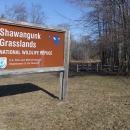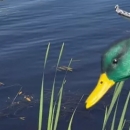About Us
The Great Swamp National Wildlife Refuge (NWR) is one of more than 560 refuges in the National Wildlife Refuge System that is administered by the Department of the Interior's U.S. Fish and Wildlife Service. Great Swamp is here to conserve its natural resources for the America public while protecting threatened and endangered species for future generations. The National Wildlife Refuge System is a network of lands and waters managed specifically for the protection of wildlife and its habitat. It represents the most comprehensive wildlife management program in the world.
The Great Swamp NWR is located in Morris County, New Jersey, about 26 miles west of Manhattan's Times Square. The refuge was established by an act of Congress on November 3, 1960. Today the refuge consists of 7,768 acres of varied habitats, and the refuge has become an important resting and feeding area for more than 244 species of birds. Fox, deer, muskrat, turtles, fish, frogs and a wide variety of wildflowers and plants can be found on the refuge.
The Wilderness Act of 1964 created the National Wilderness Preservation System in order to ensure that an increasing population, accompanied by expanding settlement and growing mechanization, does not occupy and modify all areas in the United States, and its possession, leaving no lands designated for preservation and protection in their natural condition. The Great Swamp Wilderness Act of 1968 established the first wilderness area wilderness area
Wilderness areas are places untamed by humans. The Wilderness Act of 1964 allows Congress to designate wilderness areas for protection to ensure that America's pristine wild lands will not disappear. Wilderness areas can be part of national wildlife refuges, national parks, national forests or public lands managed by the Bureau of Land Management.
Learn more about wilderness area designated within the Department of the Interior.
Our Mission
Refuge Purpose(s)
Each unit of the National Wildlife Refuge System is established to serve a statutory purpose that targets the conservation of native species dependent on its lands and waters. All activities on those acres are reviewed for compatibility with this statutory purpose.
Great Swamp NWR was established by an act of Congress on November 3, 1960 and formally dedicated in 1964, primarily under the authorities of the Migratory Bird Treaty Act of 1918 (16 USC 703-711) and the Migratory Bird Conservation Act of 1929 (USC 715- 715s, 45 Stat. 1222) as amended, for the following purpose: “…for use as an inviolate sanctuary, or for any other management purpose, for migratory birds.” Based upon land acquisition documents and authorities, additional refuge purposes were identified as follows: "...suitable for (1) incidental fish and wildlife-oriented recreational development, (2) the protection of natural resources, (3) the conservation of endangered species or threatened species ..." (16 U.S.C. 460k-1, Refuge Recreation Act); "... the conservation of the wetlands of the Nation in order to maintain the public benefits they provide and to help fulfill international obligations contained in various migratory bird treaties and conventions ..." (16 U.S.C. 3901(b), Emergency Wetlands Resources Act of 1986); and to conserve (A) fish or wildlife which are listed as endangered species or threatened species .... or (B) plants ..." (16 U.S.C. 1534, Endangered Species Act of 1973). As stated in a letter, dated 1962, from FWS Director Daniel H. Janzen to U.S. Congressman, Peter H.B. Frelinghuysen, Jr. of the New Jersey Fifth Congressional District, which covered most of Morris County: “The major objective of this refuge, other than to provide protection and preservation of the migratory waterfowl resource, is to provide an outdoor laboratory which will permit the people of the heavily populated surrounding area to engage in the above pursuits” (USFWS 1987).
Our History
In 1959, the Port Authority of New York and New Jersey announced plans to consider Great Swamp as a potential site for a commercial jet airport. As a result of major opposition, local citizens formed the Great Swamp Committee of the North American Wildlife Foundation, and through a national campaign, raised 1 million dollars to acquire nearly 3,000 acres. The Foundation began acquiring these lands in 1960 with the intention to donate this area to the United States. The refuge was established by an act of Congress on November 3, 1960. Today the refuge consists of 7,768 acres of varied habitats, and the refuge has become an important resting and feeding area for more than 244 species of birds. Fox, deer, muskrat, turtles, fish, frogs and a wide variety of wildflowers and plants can be found on the refuge.
In 1966, the National Park Service designated Great Swamp NWR a registered National Natural Landmark National Natural Landmark
The National Natural Landmarks Program preserves sites illustrating the geological and ecological character of the United States. The program aims to enhance the scientific and educational value of the preserved sites, strengthen public appreciation of natural history and foster a greater concern for the conservation of the nation’s natural heritage. The program was established in 1962 by administrative action under the authority of the Historic Sites Act of 1935. The first National Natural Landmarks were designated in 1963. Today, there are more than 600 National Natural Landmarks in 48 states, American Samoa, Guam, Puerto Rico and the U.S. Virgin Islands.
Learn more about National Natural Landmark under the provisions of the Historic Sites Act of 1935. The refuge was chosen for the registry as an “exceptional example of the natural history of the United States.”
In 1967, 746 acres in the eastern portion of the present Wilderness Area were declared a Research Natural Area by the Director of USFWS. This area contains natural shrub swamp habitat and many small upland islands.
This eastern portion of the refuge, comprising 3,660 acres is managed to maintain a Wilderness character while providing habitat for wildlife. The Great Swamp Wilderness Act of 1968 established the first wilderness area wilderness area
Wilderness areas are places untamed by humans. The Wilderness Act of 1964 allows Congress to designate wilderness areas for protection to ensure that America's pristine wild lands will not disappear. Wilderness areas can be part of national wildlife refuges, national parks, national forests or public lands managed by the Bureau of Land Management.
Learn more about wilderness area designated within the Department of the Interior. The Wilderness Act of 1964 created the National Wilderness Preservation System in order to ensure that an increasing population, accompanied by expanding settlement and growing mechanization, does not occupy and modify all areas in the United States, and its possession, leaving no lands designated for preservation and protection in their natural condition.
The Great Swamp National Wilderness was the first wilderness area designated within the Department of the Interior.
Other Facilities in this Complex
Great Swamp is managed as part of the Lenape National Wildlife Refuge Complex. A National Wildlife Refuge Complex is an administrative grouping of two or more refuges, wildlife management areas or other refuge conservation areas that are primarily managed from a central office location. Refuges are grouped into a complex structure because they occur in a similar ecological region, such as a watershed or specific habitat type, and have a related purpose and management needs. Typically, a project leader or complex manager oversees the general management of all refuges within the complex and refuge managers are responsible for operations at specific refuges. Supporting staff, composed of administrative, law enforcement, refuge manager, biological, fire, visitor services, and maintenance professionals, are centrally located and support all refuges within the complex.
Other refuges in the Lenape Complex include: Cherry Valley NWR, Shawangunk Grasslands NWR, Wallkill River NWR.



